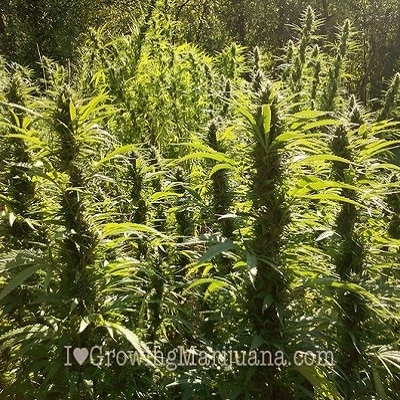You can plant marijuana outside in the late spring all the way through to the middle of July. Planting earlier basically ensures a much bigger plant. Starting late can prevent the plants from getting too large before flowering begins. The plants can be placed in garden soil where they generally do very well, or they can be grown in five- to twenty-gallon containers. Plants growing in larger containers will naturally produce more bud.
Pruning is sometimes a necessity to keep the marijuana plants at a manageable size. When the main stem is cut, the lower branches increase in size, and the plant grows several other strong branches. When these are pruned, the plant becomes bushier and puts less emphasis on growing taller. Plants with the main stem clipped will produce greater yield than un-clipped plants. Download my free marijuana grow bible for more tips about growing marijuana plants.
Fertilize the plant with vegetable fertilizer mix or liquid, or use a hydroponic, vegetative formula to maximize plant growth and yield. Follow directions precisely or use less fertilizer than suggested. Never use more than the suggested amount as it can throw chemical balances out of order.
The lengthening nights of the late summer trigger the plant’s flowering stage. Some varieties will cease growing vegetatively almost instantly, but others could continue growing and quadruple in size. It generally takes between 55 and 70 days for the buds to mature after the plants have started flowering. When the plant starts flowering, switch the fertilizer to a bloom formula so that the plants will acquire nutrients needed for larger buds.
Marijuana plants switch to flowering when the uninterrupted dark period exceeds the critical time period. This period varies by variety and is usually between 8 and 11 hours. If your plants respond to a shorter dark period, they are early season varieties. Plants that respond to a longer dark period are, of course, late season varieties. Outdoor plants with a short dark period are best suited to higher latitudes.
When growing marijuana, you must account for the effects of latitude on day length. For example, June 21 is the longest day and shortest night of the year. In San Diego, dusk to dawn lasts 8 hours and 44 minutes. In St. Louis, it last 8 hours and 3 minutes and, in Boston, it lasts 7 hours and 32 minutes. As you can see, Boston’s night length is 1 hour and 12 minutes shorter than San Diego’s.
Early season varieties growing at lower latitudes (a la San Diego) will be induced to flower early in the season and will remain small even during the maturation process. The generally shorter nights during the summer at high latitudes (a la Boston) give the plants a chance to grow before they flower. A late season variety growing in the north might trigger late in the season but won’t get a chance to develop mature buds. It will not trigger during the early summer in low latitudes but it will flower earlier as a result of the longer nights and milder climate.
Marijuana’s disparate flowering habits and the varieties that produce them have led to many strategies for growing. In northern areas, short season varieties are a necessity to ensure that plants mature before the weather turns.
By contrast, gardeners in the south grow long season varieties during the summer that ripen in the fall. Certain short season varieties will start to flower soon (a month or so after the summer solstice) and will be ready for harvest in early autumn. If short season varieties are not provided with extended exposure to daylight, they will not grow large enough to produce much of a yield. Long season varieties can be planted in the fall to mature a few months after planting.
In areas that tend to stay warm throughout the year, sativas and sativa-indica varieties can be planted in the fall. They will continue growing into the winter as they flower and will be ready in about 70 to 80 days after planting.
Regardless of the latitude you live in, you can trigger the flowering stage at any time during the summer by covering the plants for a portion of each day so that the “night” period is lengthened. For example, if dusk is at 8:00 p.m., the garden needs to remain enshrouded in darkness until 8:00 a.m. the next morning. With an opaque cover over the garden during the 12-hour dark period, the plants will only receive 12 hours of light every day and will thus be triggered into flowering.
Around week six of flowering, you will begin to notice that the buds are becoming more odoriferous by the day. The non-pollinated flowers are beginning to mature and, in two or three weeks, the flowers will be ripe and ready. This can be observed when the stigma dries, the ovary swells, and the capitate trichomes swell with resin and fluoresce. Buds that get the most light will ripen first in most cases. Remove them, but leave the unripe buds to continue ripening. They will be ready within 10 days.
If you want to start growing, download my free grow guide and order some marijuana seeds. All top quality marijuana seeds are available in my marijuana seed shop. We ship seeds to the US, CA and many other countries. For any growing related question please visit the marijuana support page.
Source: ILoveGrowingMarijuana.Com








